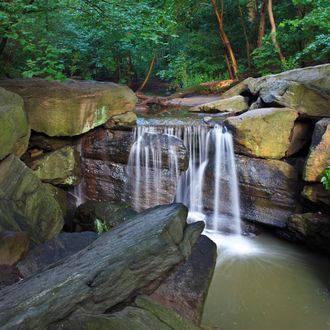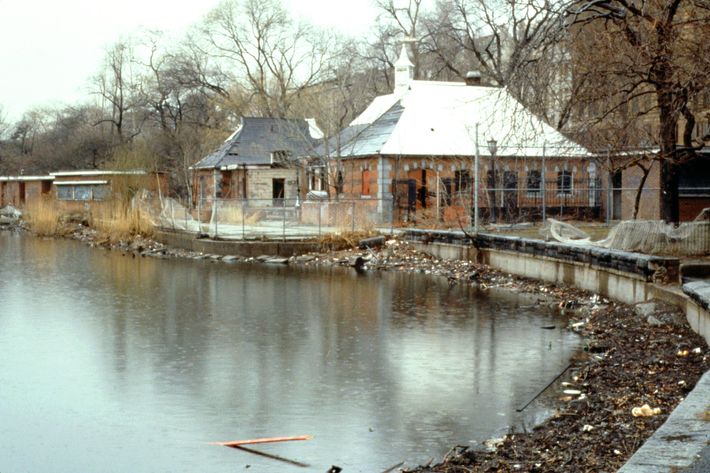
For much of its existence, Central Park has been a weedy dump. You wouldn’t know that now, as tourists on rented bikes wobble among downy lawns and iridescent cherry blossoms, and New Yorkers who grew up in the 1940s and ’50s will remember the afterglow of Robert Moses’ ministrations. But even the army of horticulturists and maintenance workers who putt-putt around on golf carts each morning can only do so much to prevent old structures from crumbling, alien species from invading, waterways from silting up. Fortunately, half a billion dollars will buy a lot of planting and digging, though — enough, maybe, to turn Central Park back into the place it was supposed to be and also ward off future neglect.
That astronomical number comes from adding up the $100 million that hedge fund manager John Paulson gave the park in 2013, the $90 million that the city kicked in six months later, and the $300 million goal of the Central Park Conservancy’s new fundraising campaign. (It’s already more than a third of the way there.) A quickstep march through the North Woods with Conservancy president Doug Blonsky clarifies the relationship between greenbacks and greenery: The difference between a romantic stream and a weed-choked sump is colossal amounts of cash.
“The wildest-looking places in Central Park are among the most intensively managed,” Blonsky says. We’re standing by the Ravine, where water once tumbled over artfully placed boulders and echoed beneath a stone arch. Now, the flow has slowed to a meager trickle, thanks to 150 years’ worth of silt. Workers have already started to dredge and widen the stream bed and clear out thickets of invasive Japanese knotweed. But Blonsky has a biggie on his wish list: Restore the dramatic open view that Olmsted and Vaux framed with a second arch and that was later walled off by Lasker Rink and Pool. Getting it right would mean rebuilding, or maybe moving the facility. Later, Blonsky takes me to an asphalt patch in the Ramble with a view onto the Lake and shows me a drawing of a rustic gazebo fashioned out of twisted branches. “We’re going to put that back,” he says.
Central Park has always been a work in progress, or, often, in decay. Its designers, Calvert Vaux and Frederick Law Olmsted, sculpted nature and made some provisions for their artwork’s conservation. In the Ravine, for instance, they installed a valve that can temporarily redirect a waterfall so that its course can be cleaned out. But within a few years of the park’s construction, between 1857 and 1863, Olmsted was already complaining about its neglect: “The Park is going to the devil, and [I] have grave doubt whether the undertaking to provide a rural recreation ground … was not doomed to failure because of the general ignorance of the conditions of success and the impossibility of getting proper care of it.”
By the turn of the century, it had become crowded and overgrown, and the first generation of trees was dying off. In 1930, the reservoir north of Belvedere Castle was decommissioned and drained, and Hoovervilles sprouted in the dust bowl it left behind. Only when Moses took over the system, in 1934, did the park get another vigorous round of care, which dribbled away as city funding did.
The Conservancy was founded in 1980 to a rescue a park that Blonsky recalls as a wilderness of despair: Every bench and lamppost was smashed, every structure caked in graffiti, every clearing in what is now the lovely Children’s Glade strewn with prostitutes’ mattresses. He remembers being confused by a tree with a glittering trunk: As he approached, he saw that hundreds of used hypodermic needles had been stuck into its bark.

In recent years, the private sums spent on Central Park have threatened to make it seem like a plutocrats’ indulgence. Why fuss over tulips in the Conservatory Garden when so many other green spaces and playgrounds go begging for basic maintenance? But the Conservancy has become a global think tank and a local resource, concerned less with deluxe horticulture than long-term sustainability. Olmsted warned that city dwellers depended on artificial wilderness to fight such urban ills as “vital exhaustion,” “nervous irritation,” “constitutional depression,” and “excessive materialism.” Today we ask urban parks to do much more than merely make us happy and healthy: They cool and clean the air, host migratory birds, foster business, boost a city’s global appeal, and represent our egalitarian aspirations. So let the wealthy write their checks and the Conservancy spend their fortunes to ensure that one of the world’s great urban landscapes stays that way in perpetuity, and let the city spread its limited resources on other less glamorous but equally crucial parks. No more needle trees.






























